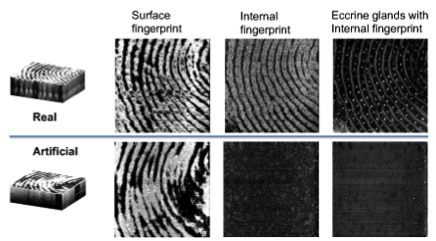Enhanced Biometric Confirmation for Security |
||
|---|---|---|
|
Fingerprint identification is commonly used in biometric access control systems. Automated Fingerprint Identification Systems (AFIS) image the fingertip surface and analyze features such as whorls, arches, and ridge bifurcations. Analyzing finer fingertip features (such as the distribution of sweat pores) has been shown to improve the accuracy of fingerprint identification. However, the reliance on fingertip surface information makes AFIS susceptible to counterfeit fingertips, which can be routinely duplicated with low-cost materials and techniques. A potentially more secure source of biometric information is the distribution of eccrine sweat glands, which are located below the skin surface. A typical fingertip surface contains over 100 glands per cm2, which provides a high density of biometric information. The distribution of eccrine glands does not change during adulthood. Since every eccrine gland terminates into a pore, the improved identification accuracy obtained by the analysis of sweat pores should also apply to eccrine sweat glands. Their subsurface location makes them extremely difficult to counterfeit in comparison to the exposed ridges of the fingertip surface. Eccrine glands can be used as an extra level of security due to their distinctiveness, universality, and permanence. Researchers at the University of Delaware propose a more reliable biometric technology using spectral domain optical coherence tomography (SD-OCT) to image the subsurface of a fingertip. SD-OCT has the spatial resolution and penetration depth to readily visualize eccrine gland ducts located in the epidermis. The three-dimensional (3-D) imaging capability of SD-OCT also visualizes the undulation of the dermis, which forms an “internal fingerprint” pattern nearly identical to the conventional surface fingerprint. SD-OCT can therefore provide “triple layer” information regarding the fingertip surface, eccrine gland distribution, and internal fingerprint. The spoof-proof ability of our SD-OCT approach is clearly demonstrated by comparing the eccrine gland maps and internal fingerprints of live fingers with those of their artificial counterparts. Additional general information:
Additional technical information: |
||
|
With OCT, real human fingerprints (top) are clearly |
||




